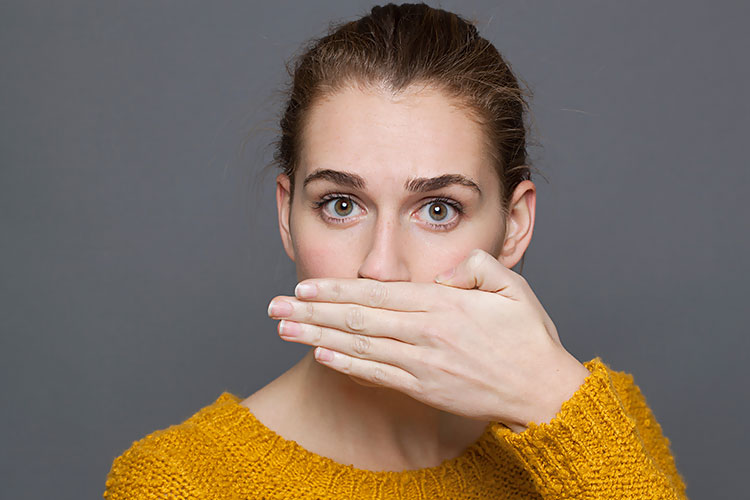Controlling Halitosis or Bad Breath
Bad Breath or Halitosis–Causes and Cures
Halitosis, also known as bad breath, is an unpleasant and embarrassing condition which can severely affect self-esteem and your relations with others. Exhaling a foul reek with each word is something that can give even the boldest person pause, and can have serious emotional and social consequences. Furthermore, in some cases, it is a symptom of a serious internal medical problem which needs attention before it reaches an alarming stage. Both work associations and intimate relationships can suffer as a result of halitosis, and emotional impacts can include loss of self-confidence, feelings of depression and isolation, and general misery.
Here at the office of Dr. Gibbs, we treat halitosis as a serious medical problem and will do our best to help you free yourself of bad breathe. This problem is very frequent, and in the United States alone slightly less than one-third of people suffer from it. There are many potential causes for this condition, which helps to explain why it is so widespread:
- Lack of sufficient dental hygiene is one common answer, though people are too often willing to condemn others who have halitosis on the assumption that they simply aren’t taking care of their oral health. If food particles become caught in the spaces between teeth, beside the gums, or in the folds of the molars, they can putrify and serve as breeding grounds for bacteria, creating a characteristic “rotten egg” bad breath.
- Going on a strict diet can cause halitosis. A similar phenomenon is “morning breath,” which is caused by the long hiatus in eating that occurs while we sleep. If someone does not eat often enough, the result can be an unpleasant smell on their breath.
- Smoking or using chewing tobacco are also frequent causes of bad breath. There are many constructive methods of quitting this addictive, dangerous habit, and most dentists can suggest these and other resources for freeing yourself from tobacco use.
- Some foods contain compounds that transfer to the bloodstream and emerge through the lungs while breathing. Garlic and onions are notorious for this. The only way to get rid of this type of halitosis is to stop eating the food in question. Once the body has finished processing the food, it will eliminate the compounds from the system and the person’s breath will return to normal.
- Dry mouth lessens the flow of saliva, which in turn prevents flushing of food particles and bacteria which, in a wetter environment, would be swallowed. Several different causes for dry mouth are possible, including breathing through the mouth, taking certain medicines, or suffering from diabetes. Some conditions may be treatable, which will incidentally eliminate the dry mouth syndrome (also called xerostomia). Other simple solutions include making use of sugar-free candy, drinking more water, or getting a prescription for artificial saliva from your dentist.
- A number of medical problems can cause bad breath. These include diabetes (already mentioned) plus chronic sinusitis or bronchitis, gastric diseases, liver problems, or kidney dysfunction. Lung or throat infections are also a possible source of bad breath. Such serious causes are usually only sought after the more obvious, simpler solutions have been eliminated, however, since they are relatively unlikely and more costly to treat.

The Number One Cause of Halitosis
One origin for halitosis stands head and shoulders above all the others, however – dental problems. Tonsil stones, or tonsilloliths, are not widely known as a possible cause, yet are one of the leading causes of bad breath. These hard accretions of debris and bacterial biofilm can be extracted from the tonsils by your dentist using a specialized metal scoop or a laser treatment.
Cavities, decaying teeth, broken or leaking fillings, impacted teeth, thick layers of untended plaque, and periodontal disease are all prime candidates for the source of reeking breath, too. All of these oral problems create habitats where bacteria can multiply and release sulfur byproducts, creating the rotten smell of halitosis. Similarly, abscesses, full or partial dentures, fungal infections, and oral tumors can all create distasteful odors, too.
Fortunately, there are many steps you can take to conquer these halitosis-causing problems:
- Receive treatment from your dentist for whatever is wrong, be it cavities, gum disease, or tonsil stones.
- Carry out proper dental hygiene, including brushing at least twice daily with a fluoride toothpaste. Floss should be used at once daily.
- Use of a tongue scraper on the portion of the tongue nearest the throat. This removes biofilms and eliminates bacteria from one of their favorite haunts.
- Avoid standard mouthwashes. These usually just mask halitosis and do not change the conditions that create it. In fact, they can contribute by drying the mouth.
- Chlorine dioxide mouth rinse is an option that neutralizes the sulfur compounds at the heart of most halitosis. We can help you create a program to use this product to maximum effect. Ropar is a mouth rinse available at Walgreen’s and Wal-Mart, among many others. We can also order other rinses with a similar effect.
Our first priority is restoring your oral health and cleanliness, and give you fresh breath again!
If you would like to know more about halitosis and bad breathe, call 630-749-2523 today or make an appointment online.
Check Up
Make an Appointment Today!
Need a Smile Makeover, full mouth reconstruction or cosmetic procedure like veneers or crowns? Set up an appointment now without picking up the phone.
Hours
Monday: 11am – 8pm
Tuesday: 10am – 7pm
Wednesday: 8am – 4pm
Thursday: 7am – 3pm
Friday: Closed
Saturday: Closed
Sunday: Closed
